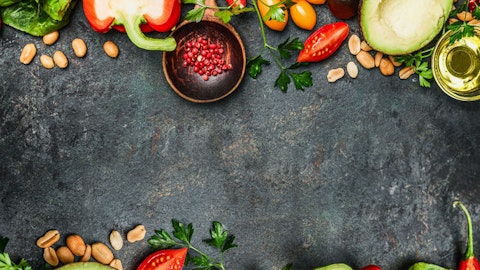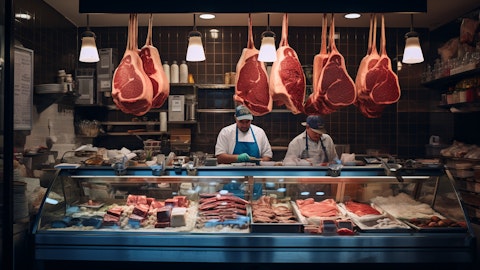John R. Tyson: Yes, Ben. The answer to that question is, we do factor in some range of market conditions, although I would say in the band of our year-over-year improvement, it’s probably about two thirds of that is what we’re seeing from operations and one third of that year-over-year improvement has to do with some favorable grain prices and chicken market prices is how we think about that. And then I described earlier, obviously, how we get to the different outcome within the range. Wes is here with me, and maybe I can invite you just color a little bit more on the year, Wes.
Wes Morris: Yeah. Thanks for the question, Ben. As John said, I classify it — one-third of our improvements will be baked around markets, so grains, net of meat values, two-thirds driven by our fundamental improvements. And I’ll give you some examples. Nice improvement in Q4 in our live production led by livability, fee conversion and hatch. Our capacity and our yields were both up, while turnover and absenteeism were down. Our service was up materially year-over-year, and we did it with $84 million less finished inventory pounds. And so trending in the right direction. We also have a very disciplined supply demand balance process in place. And so balance and supply demand and capacity to maximize profits while servicing customers. And so we’re on track, improving our fundamentals, servicing customers and shifting our mix to drive profitability. But I agree with John, one-third markets, two-thirds performance.
Ben Bienvenu: Very, very helpful. Thank you. My second question is a follow-up question on the balance sheet for next year. As it relates to the $400 million of net interest expense in 2024, John, does that include the refinancing of the $1.25 billion of debt you have maturing in August? And/or is there something else that you guys might consider either downsizing that debt or something else to manage the balance sheet as you think about maturities in 2024?
John R. Tyson: Yeah. So we’d be projecting to refinance any upcoming maturities. I think we also have a term loan that we executed earlier this year to draw in November. And so just the rebalancing of the portfolio and the combination of the fixed and floating is where you see the rate — the total interest expense tick up year-over-year.
Ben Bienvenu: Okay. Great. Thanks so much. Best of luck.
Operator: Our next question comes from Ben Theurer from Barclays. Please go ahead with your question.
Unidentified Analyst: For sure. Thanks so much. This is [indiscernible] on for Ben. Just a question for Chicken. In terms of your factory closure, I know there’s two already closed or in process, can you confirm that? And also, what would you say is your current capacity utilization as of now? And then maybe any stats on reduced costs? Also, I just wanted to confirm for the $333 million write-down in fees, this relates to the two fresh meat case ready value-added facilities you said you took offline? Thank you.
Donnie King: So let me start off, and I’ll answer the Beef question first. The write-down in Beef doesn’t have anything to do with that. That was discount rates, which drove the goodwill impairment. But in terms of Chicken, let me just state this because we’ve not said this in some time. Our goal in Chicken is to simply be the very best in this space. That hasn’t changed. I can tell you that over the last three, four, five years, maybe we haven’t done that to the best of our ability. We haven’t competed very well. But we’re getting more competitive, and we are still unlocking opportunities. And I’ll let Wes share some of the things that he’s doing in addition to what he’s already said.
Wes Morris: Yeah. Let me see if I can answer your question. And so at this point, five of the six that we announced are in fact, are done producing with the last one coming offline at the 1st of March. In our Q4 financials, only two of those would have been driving those numbers with the remaining ones coming in Q1 and early Q2. As for capacity, yes, let me go ahead and I’ll touch on the capacity. Our goal is to always have room to grow with our important customers, but we have moved up materially year-over-year with both the closures and other activities. But I would remind you that mix is as important as volume in driving our profitability across our total portfolio.
Unidentified Analyst: Great. Thank you so much.
Wes Morris: Thank you.
Operator: And our next question comes from Michael Lavery from Piper Sandler. Please go ahead with your question.
Michael Lavery: Thank you. Good morning. I just wanted to come back to — you said your first priority was being disciplined with cash, but you also pointed out that you’ve raised the dividend. It’s a modest increase. I realize that. But I guess why the rush to take it up at all? Is it just that time of year? Is there a reason — with especially an outlook with a bit of uncertainty that you couldn’t just put that on hold? So let me understand that thing and am I hearing correctly that it sounds like the flex comes from adjusting CapEx down? Is that the right trade-off? How should we think about that?
John R. Tyson: This is John. I’ll take that question. So as I mentioned earlier, we remain committed to growing the dividend, preserving dividend this year and growing it over time. I understand the question. I think our judgment was that on an absolute basis, about a 2% increase in terms of cents per share was modest and fit well within the range of outcomes for our capital allocation in ’24. So I think that’s how we answer that question.
Donnie King: If I could add something to that in terms of CapEx. As a reminder, over the last couple of years, we’ve made major investments in capacity, and we’re pulling that back down to normal levels. We are in a good spot today in terms of the capacity to produce and to be able to produce and grow in the near term here. We’ll certainly keep our eye on that. But I think another way to think about that is you’re just returning to more of a historical level of capital spend.
Michael Lavery: Okay. That’s helpful. And I just want to follow up on the Prepared Foods commentary. This has been touched on a little bit, but you called out the difficult consumer environment and how you’re trying to meet those consumers where they are. I guess, just at a higher level. Can you give a sense of how you prioritize the sort of volume over price? What’s the key driver in terms of how you think about approaching what could be a further step-up in promotions? Or just how you manage that going forward?




